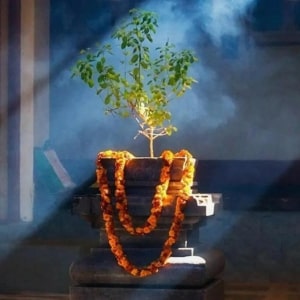Tulsi Vivah, a sacred Hindu ceremony, celebrates the symbolic marriage of the Tulsi plant (holy basil) to Lord Vishnu. This auspicious event holds great significance in Hindu culture and is marked by elaborate rituals and ceremonies. Let’s delve into the enchanting story behind Tulsi Vivah, exploring the divine union that has been revered for centuries.

Tulsi Vivah Story
The story of Tulsi Vivah is deeply rooted in Hindu mythology and revolves around the virtuous Tulsi and Lord Vishnu. According to the Puranas, Tulsi was an ardent devotee of Lord Vishnu and possessed unparalleled beauty and piety. She dedicated her life to the worship of Vishnu and harbored a deep desire to be united with him.
Legend has it that Tulsi was once a devoted princess named Vrinda. Due to a twist of fate, her husband Jalandhar, a demon king known for his invincibility, fell into a confrontation with Lord Shiva. The gods, troubled by Jalandhar’s growing power, sought Lord Vishnu’s help. Vishnu, in his pursuit to defeat Jalandhar, took the form of Vrinda’s husband, deceiving her momentarily.
Tragically, when Vrinda discovered the truth, she was devastated. In her anguish, she cursed Lord Vishnu, condemning him to turn into a stone. Realizing the gravity of her curse, she then immolated herself. Touched by her unwavering devotion, Lord Vishnu promised to marry her in her next life, and it is believed that she was reborn as the Tulsi plant.
Also Read: Dev Uthani Ekadashi Puja Vidhi and Samagri
The story of Tulsi Vivah is a timeless narrative that continues to inspire and resonate with devotees. The ritual not only honors the sacred bond between Tulsi and Vishnu but also serves as a reminder of the enduring power of devotion and the ultimate triumph of good over evil. As we celebrate Tulsi Vivah, let us immerse ourselves in the rich tapestry of mythology and spirituality, embracing the divine love that transcends time and space.





